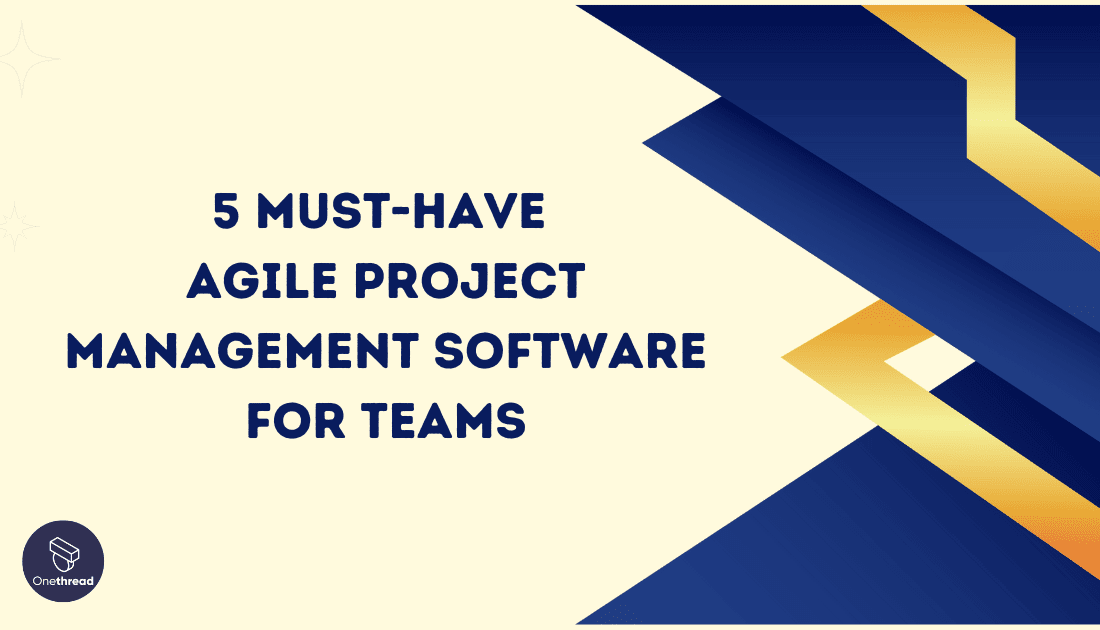Over the past 25 to 30 years, agile innovation methods have significantly increased success rates in software development, improved quality and speed to market, and boosted the motivation and productivity of IT teams.
Agile project management software is the game-changer you’ve been looking for if you want to revamp your team’s operations. Forget clunky spreadsheets and endless email threads.
And it’s not just for tech companies. Marketing teams, HR, and even your local bakery can harness the power of Agile software. So, whether you’re new to Agile or looking to level up, the right software can make all the difference.
Read on to discover the top 5 tools that will take your projects from good to outstanding. Stay ahead of the curve. Your team deserves the best.
Quick List of 5 Agile Project Management Software
- Onethread: Industry leader known for its robustness and scalability in software development.
- Asana: User-friendly with a focus on task management and team collaboration.
- Trello: Offers a simple, card-based interface that’s great for small teams.
- Monday.com: Versatile and customizable, ideal for non-tech teams as well.
- Forecast: Combines traditional project management tools with automation features.
Our reviewers evaluate software independently. Clicks may earn a commission, which supports testing. Learn how we stay transparent & our review methodology
Comparison Chart Of Agile Project Management Software
This chart quickly compares key features of these Agile Project Management tools.
Tools | Scalability | Task Management | Team Collaboration | Special Features |
 | High, great for large teams, flexible enough to be modified for specific business purposes | Custom fields, task dependencies | Team discussions, comments, announcements, file sharing | Sprint planning |
 | Medium, suits small to medium teams | Strong, with many features | Chat and file sharing | Time tracking |
 | Low, best for small teams | Basic but effective | Limited, mainly comments | Power-Ups for extended functionality |
 | High, adaptable to any team size | Versatile | In-app communication | Workflow automation |
 | High, designed for growth | Advanced with automation | Collaboration plus automation | Automation and resource planning |
What is Agile Project Management Software?

Agile Project Management Software is a digital tool designed to help teams implement the Agile methodology in their work. Think of Agile Project Management Software like a Swiss Army knife for your projects.
Just as a Swiss Army knife has multiple tools for different needs—like a blade, a screwdriver, and a bottle opener—Agile software offers a range of features for planning, tracking, and adapting. You wouldn’t tackle a camping trip with just a single tool; likewise, managing a project with diverse needs requires a versatile solution.
The software consolidates all the essential tools in one place, making navigating the challenges of modern project management easier. Just like you’d pack a Swiss Army knife for an adventure, Agile Project Management Software is the tool you need for project success.
Why Agile Project Management Software Is Important to Your Business?

Agile Project Management Software isn’t just a tool; it’s a catalyst for business growth and team cohesion.
- Efficiency Boost: Agile software streamlines processes. You get more done in less time.
- Real-Time Collaboration: Team members can update tasks and communicate in real time. This eliminates bottlenecks.
- Adaptability: Market trends change. Agile software helps your team adapt quickly to new conditions.
- Transparency: Everyone can see the status of tasks and projects. This keeps team members accountable.
- Resource Optimization: Know who is doing what and when. This helps in allocating resources more effectively.
- Risk Mitigation: Agile methods help identify issues early. You can address them before they escalate.
- Customer Satisfaction: Faster delivery and frequent iterations mean a better end product. Happy customers are good for business.
Key Features to Consider in Agile Project Management Software

When it comes to choosing Agile Project Management Software, the features make all the difference. You’ll want to consider several key capabilities to ensure that the software meets your team’s and project’s needs. From visualizing progress to enabling customer interaction, let’s delve into the must-have features to look for.
Progress Visualization
A picture is worth a thousand words, and that’s especially true for project management. Progress visualization features, like Kanban boards or Gantt charts, allow you to see the status of tasks and projects at a glance. This helps understand bottlenecks, align priorities, and make quick, informed decisions.
Issue Tracking
Every project faces hurdles. Issue tracking allows you to identify, manage, and resolve these obstacles in a systematic way. Whether a code bug or a workflow snag, this feature ensures that nothing falls through the cracks. It’s like having a built-in problem-solving mechanism for your team.
Collaboration
In the Agile methodology, collaboration is king. Look for software that offers robust communication features such as chat, file sharing, and real-time updates. This helps team members work together seamlessly, discuss changes on the fly, and keep everyone in the loop.
Estimation
Accurate estimation of time and resources is crucial in Agile projects. The software should enable features like story points or time tracking to help you gauge the scope and duration of tasks. Knowing how long a task will take can improve planning and prevent project delays.
Customer Portal
Lastly, a customer portal is invaluable for keeping clients engaged and informed. This feature allows customers to track progress, submit feedback, or raise issues directly within the platform. It’s a win-win, fostering better communication and ultimately leading to a more successful project.
Top 5 Agile Project Management Software
From scalability and user interface to special features, we’ve rounded up the top 5 tools that stand out in Agile. Whether you’re a small startup or a large enterprise, read on to find the software that will take your projects to the next level.
#1. Onethread

Onethread stands out as a top-tier Agile Project Management Software designed to meet the rigorous demands of modern business. Known for its high scalability, it’s the go-to solution for large teams and complex projects.
The interface, while robust, provides a range of advanced features that allow for in-depth task management and team collaboration. Built-in chat and forums make communication seamless.
What sets Onethread apart is its focus on sprint planning, helping you break down tasks into manageable units and track them in real time. The software adapts to your needs, making it perfect for tech-centric and non-tech teams. With Onethread, you’re not just managing projects but mastering them.
Try Onethread
Experience Onethread full potential, with all its features unlocked. Sign up now to start your 14-day free trial!
Overview and key features
When it comes to agile project management, Onethread is a cut above the rest. Known for its scalability and advanced features, it’s the tool that grows with your business. But what makes it the best? Let’s dive into its key features to find out.
Scalability
Onethread excels in scalability, making it ideal for large teams and multi-faceted projects. As your team grows or your project scope expands, the software adapts effortlessly. This ensures you’re never limited by your tools, allowing you to focus on delivering great results.
Advanced Task Management
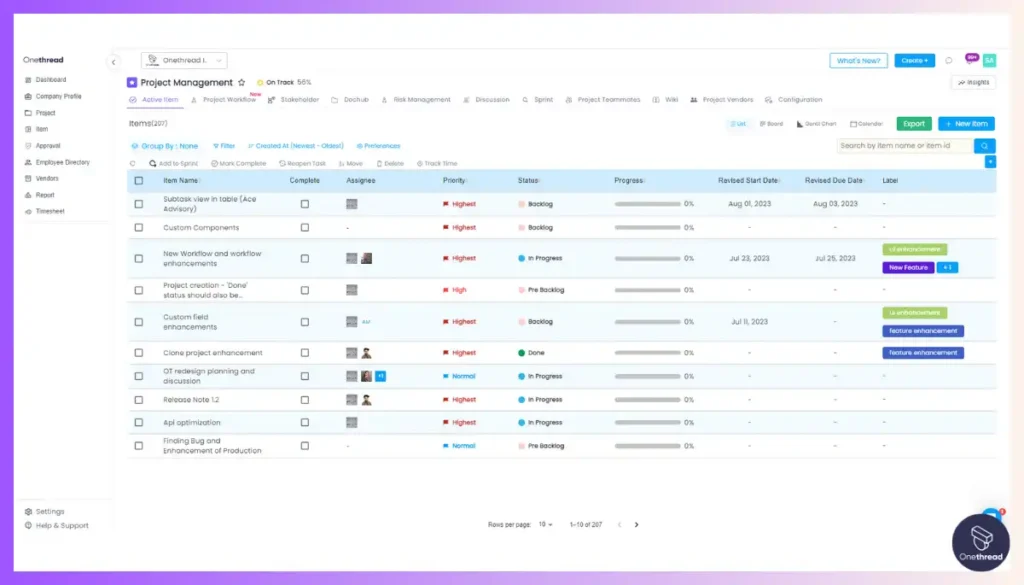
Forget about basic to-do lists. Onethread offers an advanced task management system that lets you dig deep into each task. Prioritize, set deadlines, and assign team members with ease. This detail level ensures each task perfectly aligns with your project goals.
Built-In Communication
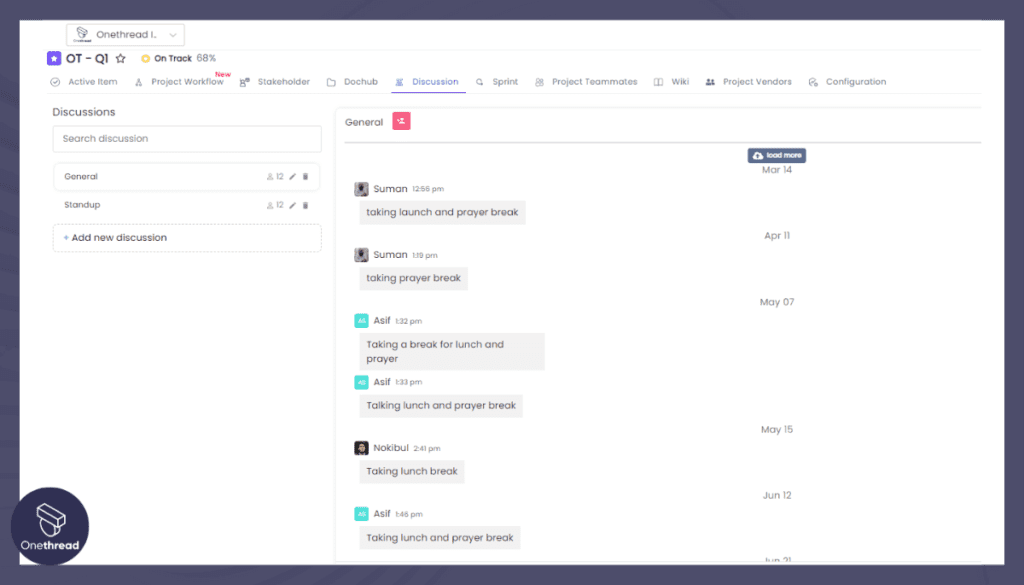
Say goodbye to switching between multiple apps for chat and project management. Onethread features built-in chat and forums that enable real-time communication within the platform. Discuss tasks, share files, and solve problems, all without leaving the software.
Sprint Planning
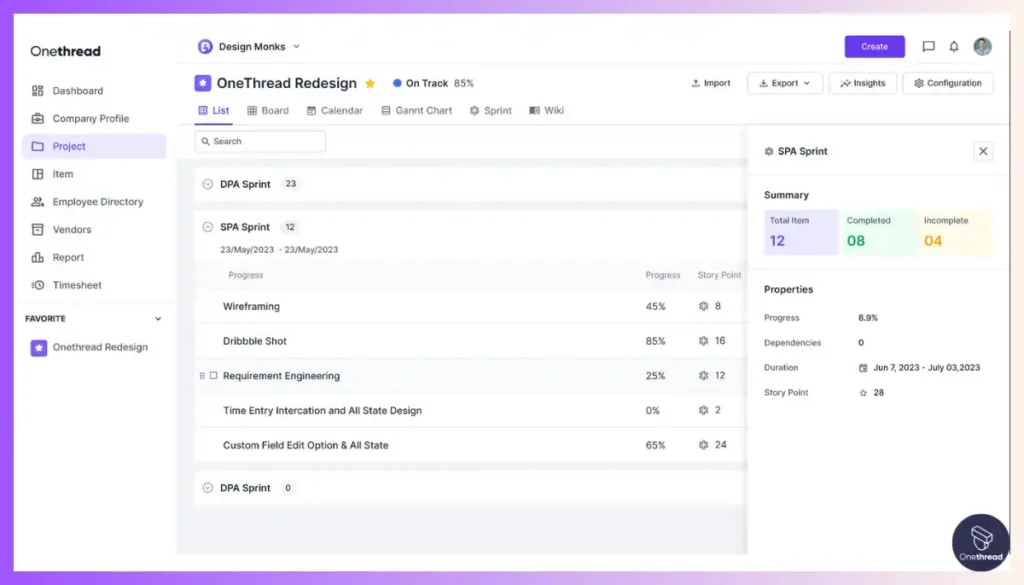
One of Onethread’s standout features is its comprehensive sprint planning tools. Plan your sprints to the last detail, allocate resources, and set achievable targets. The software keeps everyone on the same page, ensuring your sprints are executed flawlessly.
Robust User Interface
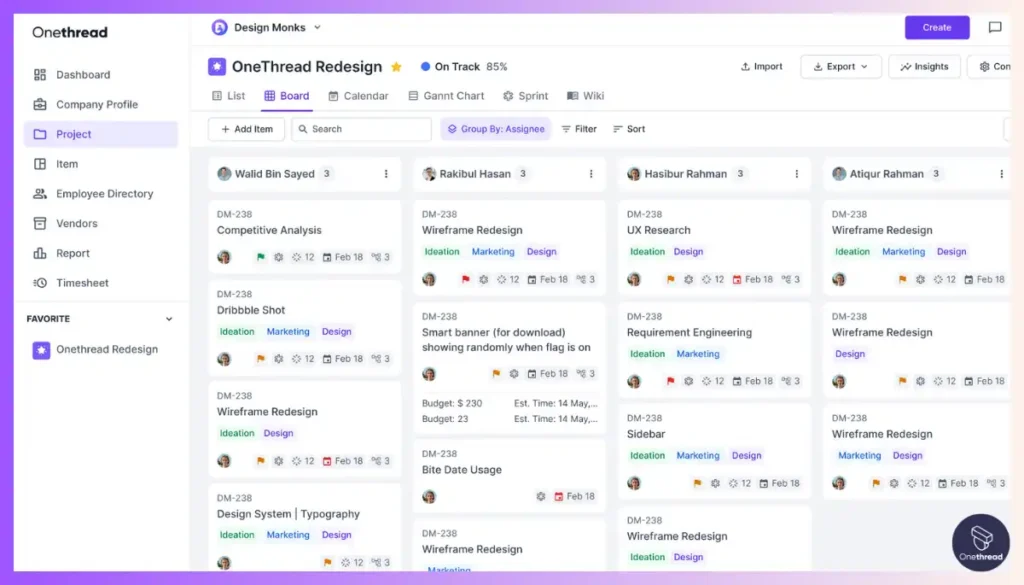
While it offers many advanced features, Onethread’s user interface is designed for clarity and ease of use. The layout is intuitive, making it easy for new users to get up to speed quickly and robust enough for seasoned pros to make the most of its many features.
Pricing plans and options

Let’s break down what each plan offers.
Free Plan
Who It’s For: Small teams or startups looking to get a taste of Agile project management.
Growth Plan – $3.6/month
Who It’s For: Growing businesses that need more than just the basics.
Scale Plan – $6/month
Who It’s For: Large enterprises or complex projects requiring full-scale capabilities.
Try Onethread
Experience Onethread full potential, with all its features unlocked. Sign up now to start your 14-day free trial!
#2. Asana
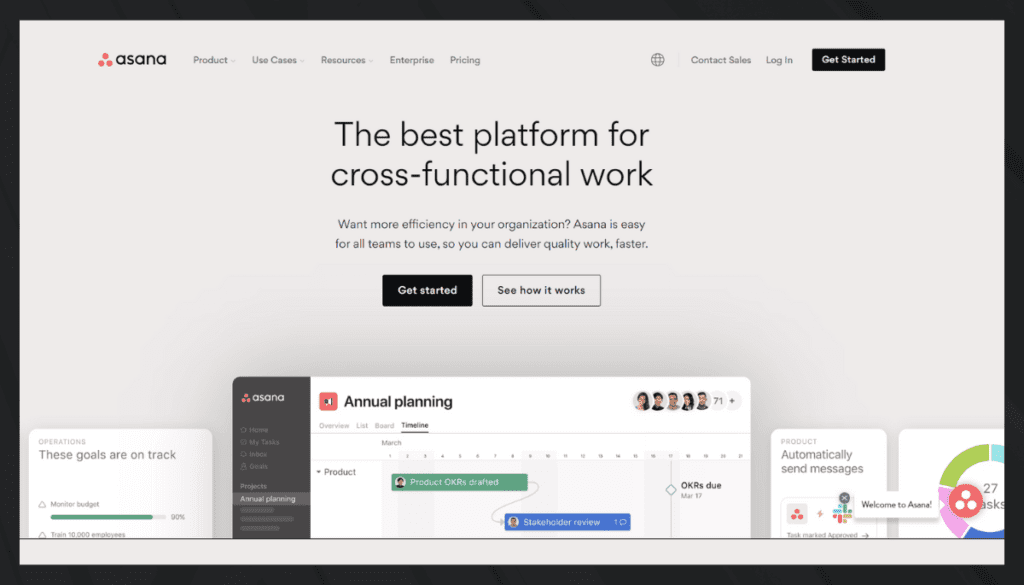
Asana is a powerful task and project management tool designed to streamline work processes. With its user-friendly interface, it helps teams collaborate efficiently. Asana allows you to easily create tasks, set deadlines, and assign responsibilities.
Its intuitive timeline and calendar features provide a clear view of project progress. Asana also enables seamless communication through comments and file sharing within tasks. With its mobile app, you can stay connected and productive on the go.
Whether you’re managing a small team or a large organization, Asana simplifies work management and boosts productivity.
Asana – Overview
Product Information:
- Company Valuation: $3.79 billion as of September 22, 2023.
- Employee Numbers: 1,782 (2023)
Founding Team:
Asana, Inc. was founded in 2008 by Dustin Moskovitz and Justin Rosenstein
Features
Below, we dive deep into Asana’s features, pros and cons, pricing, and customer ratings to give you a comprehensive overview.
User-Friendly Interface
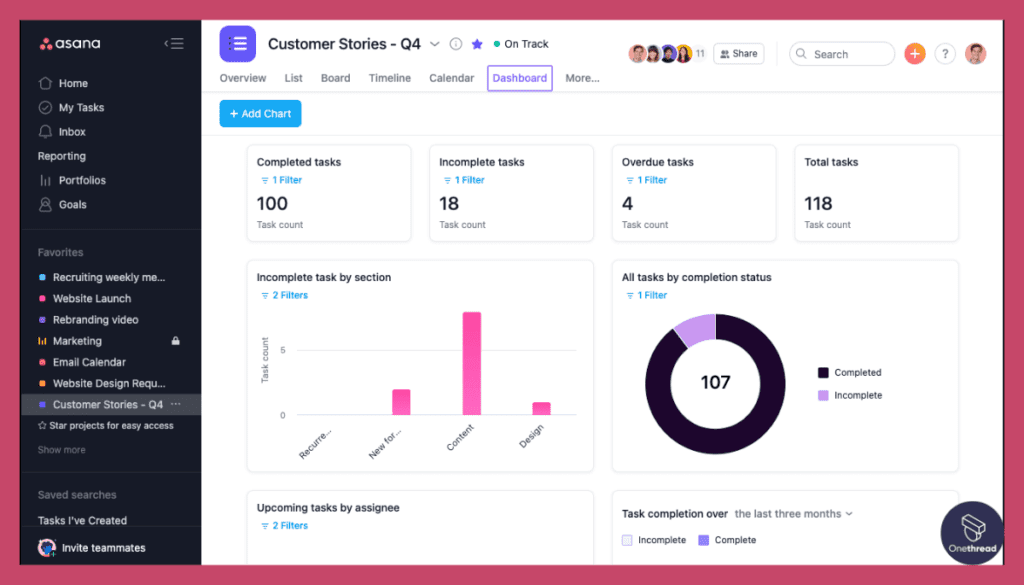
Asana offers an extremely intuitive user interface that takes virtually no time to understand. New users can quickly navigate through tasks, timelines, and chats without feeling overwhelmed. The design is clean, and the icons and menus are self-explanatory, making it highly accessible even for non-tech-savvy team members. This accessibility streamlines the onboarding process, saving you time and resources.
Strong Task Management
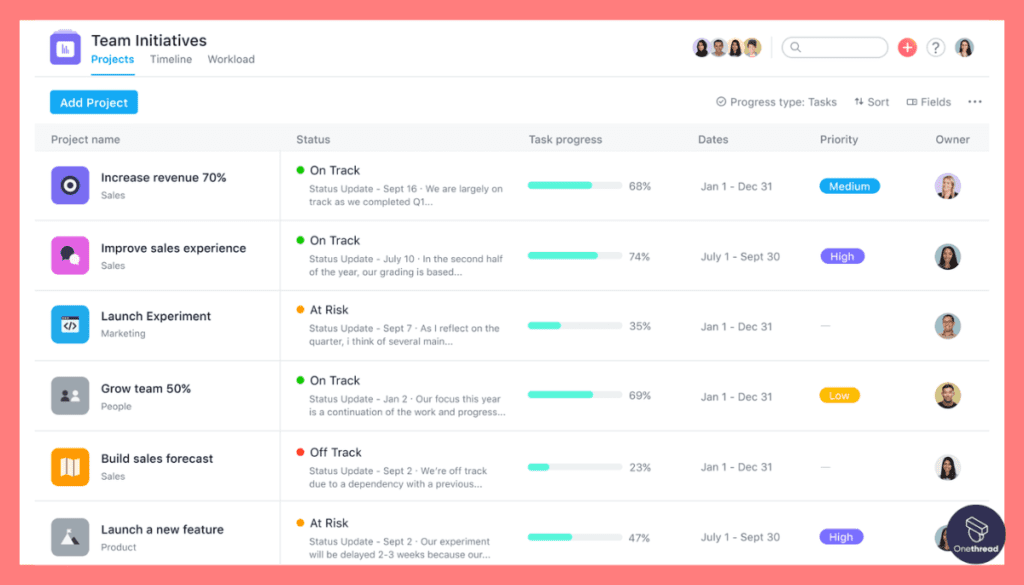
The task management capabilities in Asana are nothing short of impressive. Not only can you create and assign tasks, but you can also set dependencies, priorities, and deadlines with ease. The task management system is flexible enough to adapt to various workflows, meeting the needs of different types of projects.
Team Collaboration
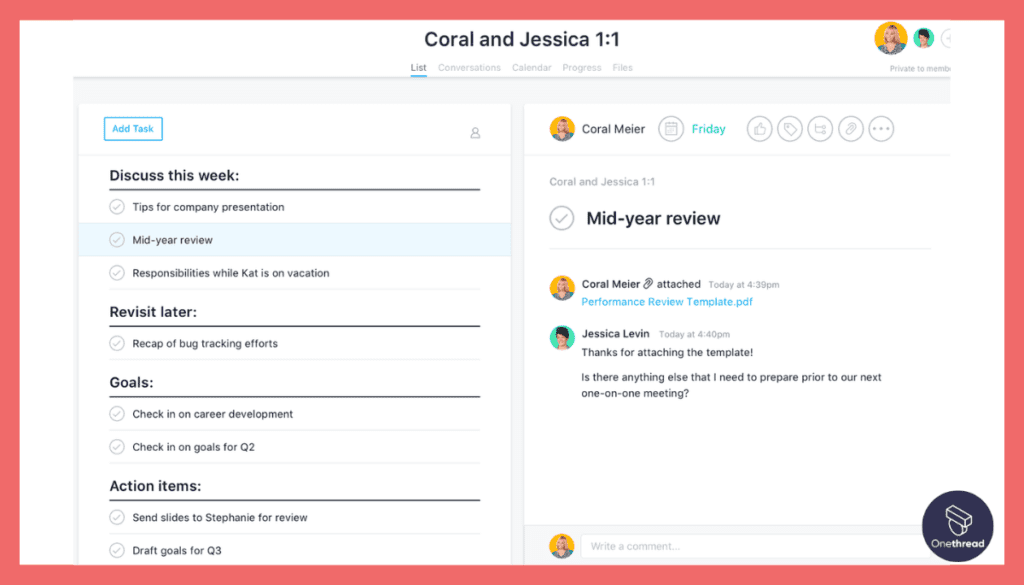
Collaboration is built into the very core of Asana. Team members can comment on tasks, attach files, and set tags without leaving the platform. In-line commenting allows for contextual discussions, greatly enhancing clarity and minimizing misunderstandings.
Automation
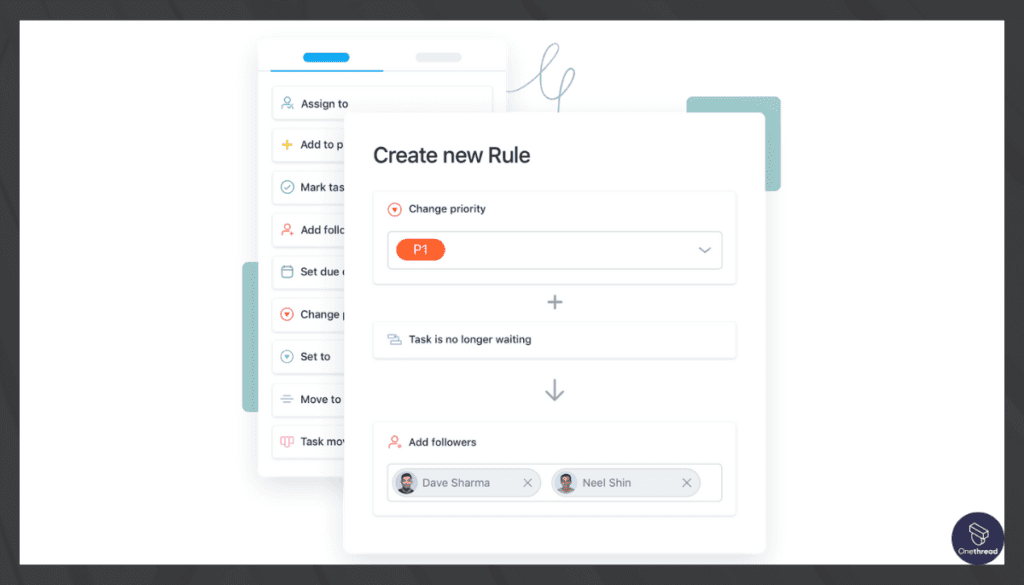
Asana’s automation features allow you to set up rule-based triggers for repetitive tasks. Whether moving a task to a different stage or assigning a new task when a milestone is reached, automation helps reduce manual work. This frees up time for more strategic activities, elevating your team’s efficiency.
Pros & Cons
Pros
- Easy to use, reducing onboarding time.
- Strong task management capabilities.
- Excellent team collaboration features.
- Versatile with plenty of third-party integrations.
- Robust automation for repetitive tasks.
Cons
- No native time tracking.
- May require paid add-ons for specialized features.
- Could be overwhelming for very small teams due to its range of features.
Pricing Plans
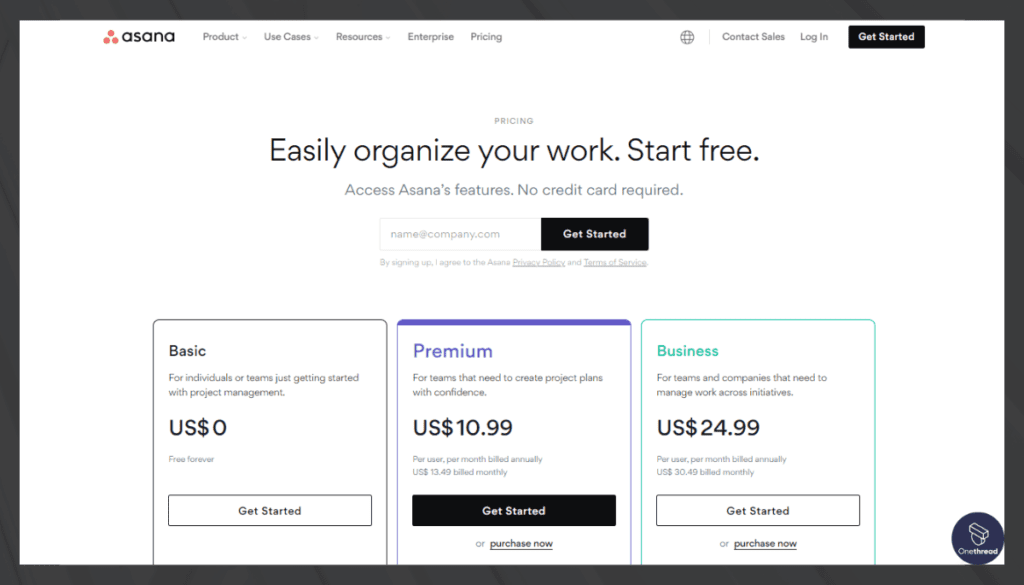
- Basic Plan: Free, limited to basic task management features.
- Premium Plan: $13.49 per user/month, includes advanced features and unlimited dashboards.
- Business Plan: $30.49 per user/month, includes advanced integration and reporting features.
Customer Ratings
- G2: 4.3 out of 5 stars
- Capterra: 4.4 out of 5 stars
Review
Asana is a popular project management tool. It excels in task organization and team collaboration. Features like boards and timelines make project tracking easy. It also integrates well with other tools like Slack and Google Drive.
However, Asana has downsides. The user interface can be overwhelming for newcomers. Advanced features like workload management are behind a paywall. Also, offline access is limited.
Overall, Asana offers robust features for teams but has a learning curve. The cost could be a factor for small businesses. It’s a strong option for those who can invest time and money.
#3. Trello
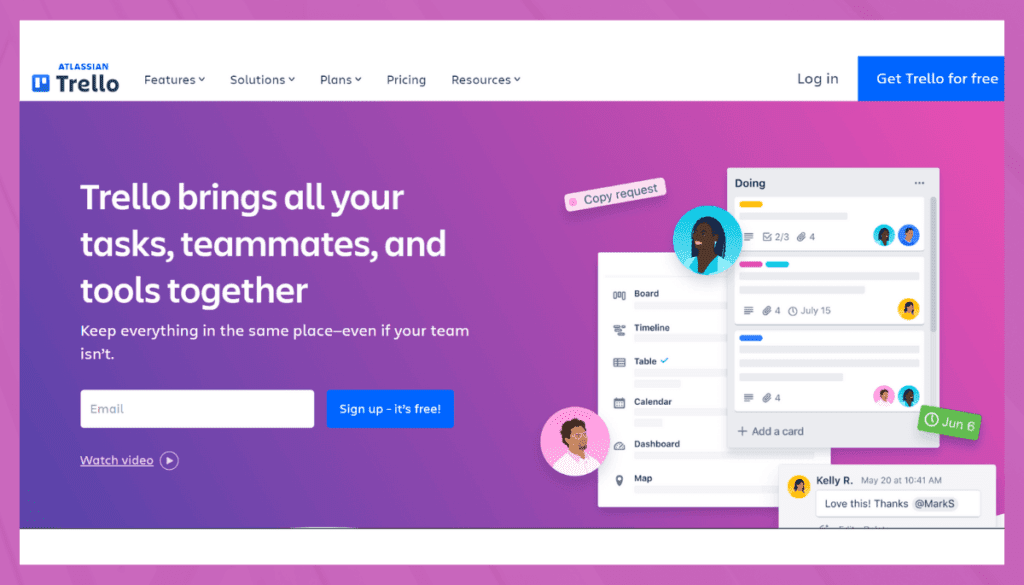
Trello is a user-friendly project management tool that simplifies task organization. Its intuitive interface employs boards, lists, and cards to help users manage projects effortlessly. With Trello, you can create customizable boards for various projects, add task lists, and move cards representing tasks as they progress.
It promotes collaboration by allowing team members to comment, attach files, and set card due dates. Trello’s flexibility accommodates different workflows and industries, making it a versatile choice for teams of all sizes.
Its mobile app ensures accessibility and productivity on the go. Whether you’re planning projects, tracking goals, or organizing personal tasks, Trello streamlines the process and fosters efficient teamwork.
Trello – Overview
Product Information:
- Company Valuation: $425 million.
- Employee Numbers: 114 Employees
Founding Team:
founders Michael Pryor and Joel Spolsky.
Features
Below, we thoroughly examine Trello’s features, pros and cons, pricing, and customer ratings.
Card-Based Interface
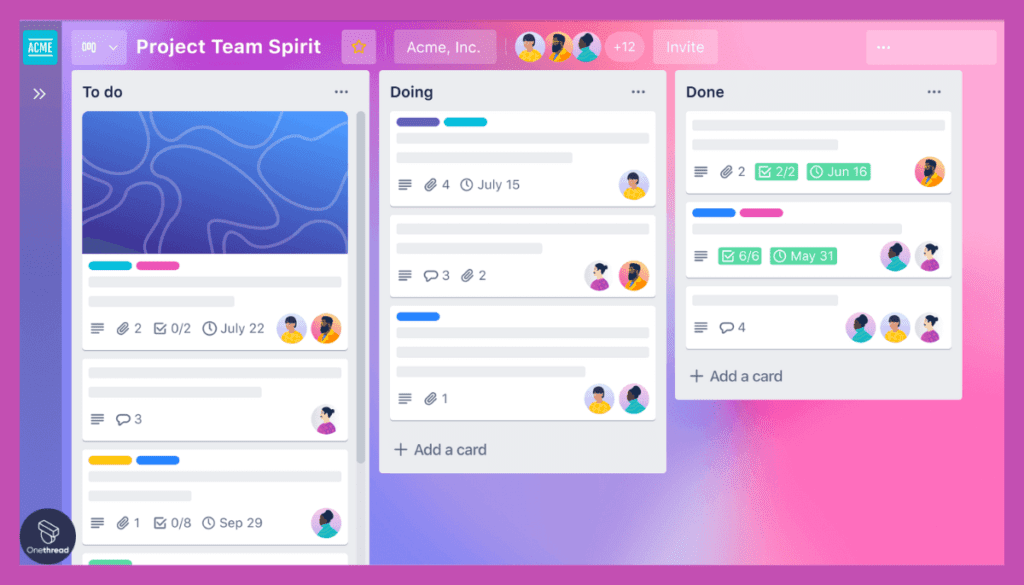
Trello’s distinct card-based interface is its standout feature. The drag-and-drop functionality allows for effortless task creation, categorization, and prioritization. Cards can be organized into lists, which in turn can be placed on boards. This makes it easy to visualize the flow of tasks from inception to completion.
Built-In Collaboration
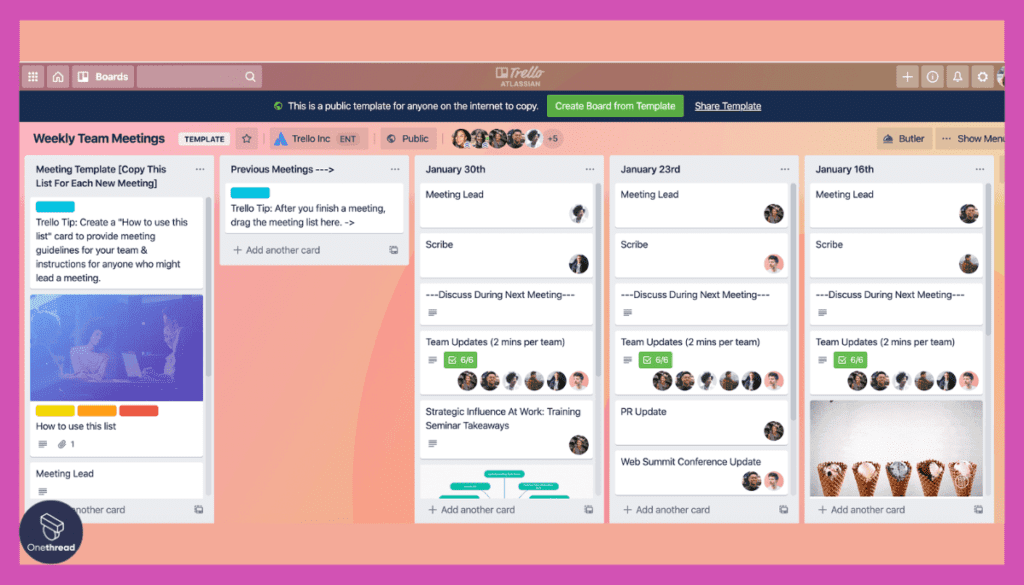
In Trello, collaboration is as easy as dragging a teammate’s avatar onto a card. Comments, mentions, and file attachments can be made directly on the card, making all relevant information easily accessible.
Automation with Butler
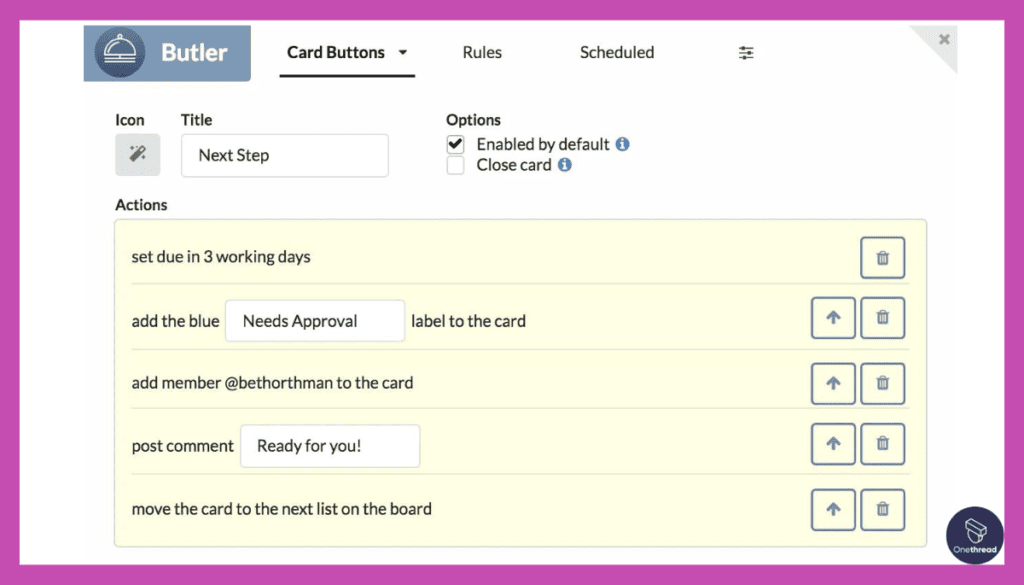
Trello’s Butler feature brings automation into your project management. With Butler, you can create simple automations called “rules” that help move cards between lists, update due dates, or even assign tasks to team members.
Integrations
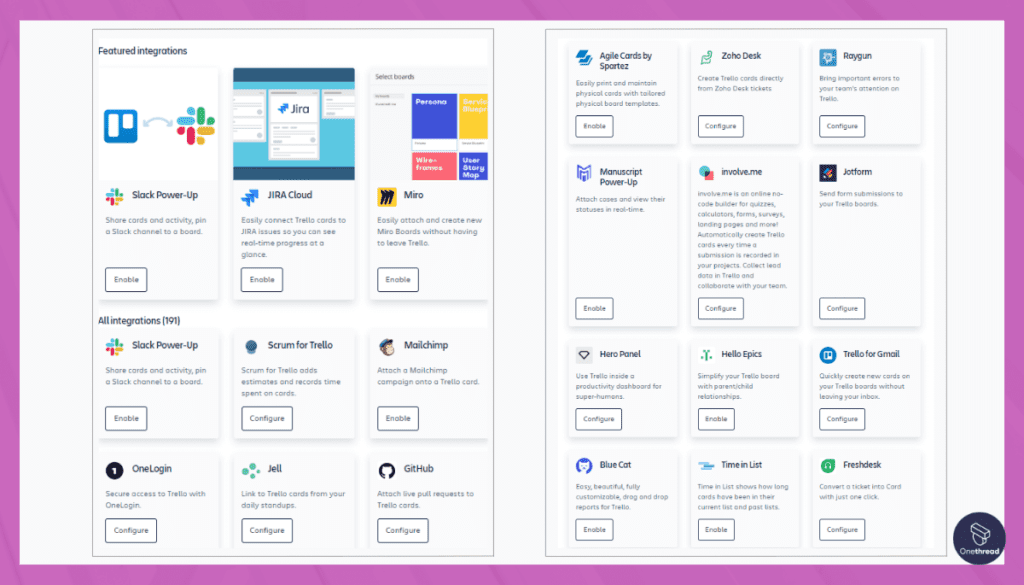
Trello is not just an island; it integrates smoothly with a host of third-party applications like Google Drive, Slack, and Jira. These integrations enhance its utility by allowing you to bring in features that Trello itself might not offer, such as advanced reporting or time tracking.
Customization
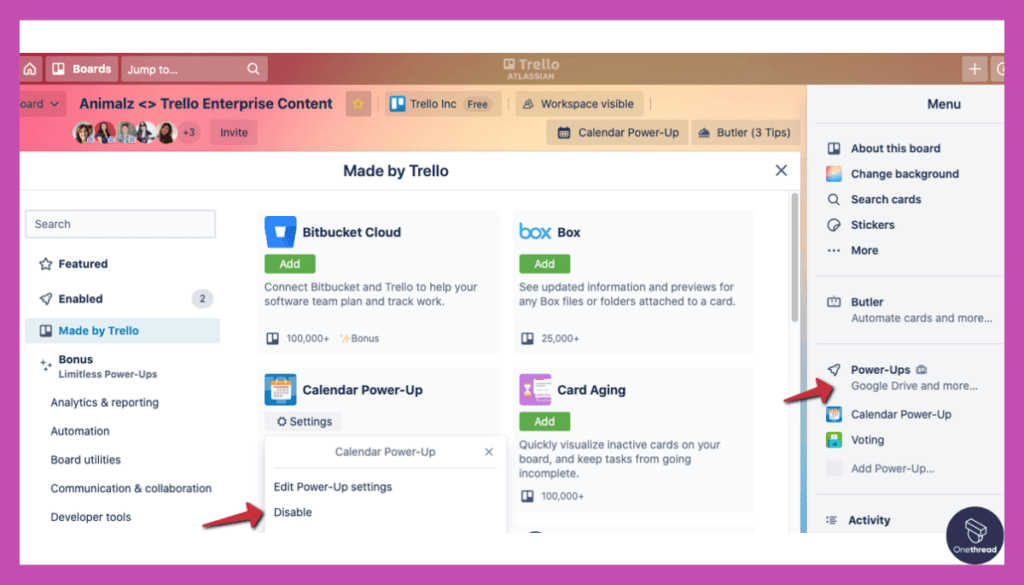
Trello offers extensive customization through its Power-Ups, enabling features like calendars, maps, and voting. You can activate Power-Ups based on the needs of your project, essentially building a project management tool tailored just for you. This level of customization allows Trello to adapt to the unique requirements of different projects.
Pros & Cons
Pros
- Highly intuitive and user-friendly.
- Excellent collaboration capabilities.
- Powerful automation with Butler.
- Wide range of third-party integrations.
- Extensive customization options.
Cons
- Limited features in the free plan.
- May not be ideal for large, complex projects.
- Lack of built-in advanced reporting features.
Pricing Plans
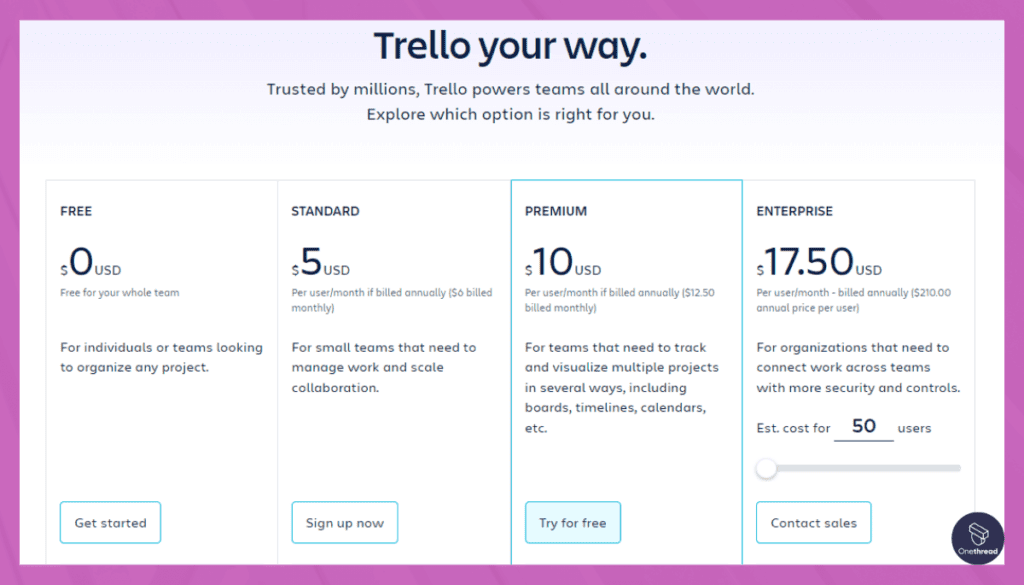
- Free Plan: Basic features, up to 10 boards.
- Business Class: $10 per user/month, unlimited boards and premium features.
- Enterprise: Custom pricing, advanced security, and administrative features.
Customer Ratings
- G2: 4.3 out of 5 stars
- Capterra: 4.5 out of 5 stars
Review
Trello is a user-friendly project management tool that simplifies task organization. Its intuitive interface employs boards, lists, and cards to help users manage projects effortlessly. With Trello, you can create customizable boards for various projects, add task lists, and move cards representing tasks as they progress.
It promotes collaboration by allowing team members to comment, attach files, and set card due dates. Trello’s flexibility accommodates different workflows and industries, making it a versatile choice for teams of all sizes.
Its mobile app ensures accessibility and productivity on the go. Whether you’re planning projects, tracking goals, or organizing personal tasks, Trello streamlines the process and fosters efficient teamwork.
#4. Monday.com
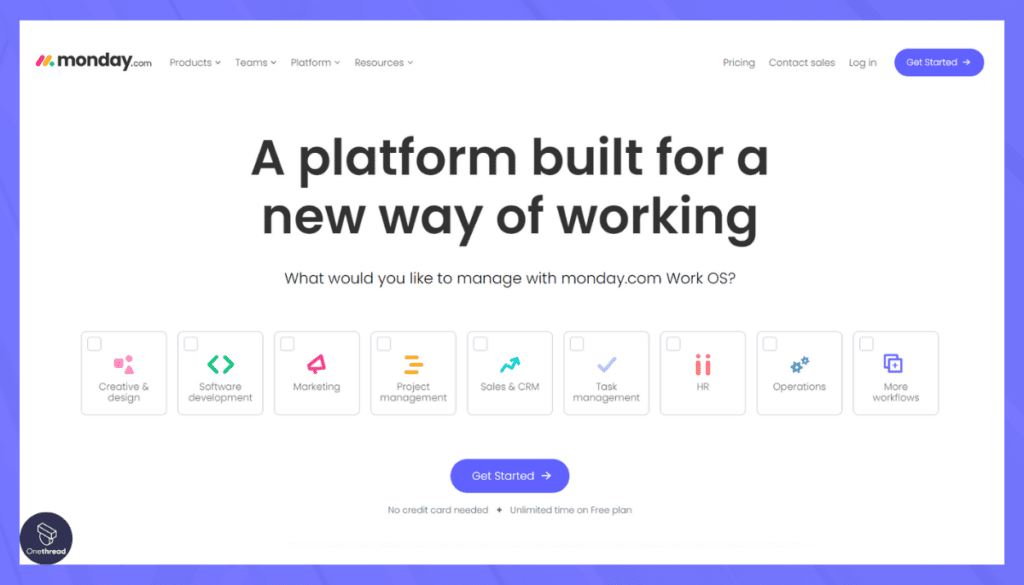
Monday.com is a versatile work operating system designed to streamline team workflow management. Its easy-to-use interface offers a centralized platform to plan, track, and execute projects. Monday.com allows you to create custom workflows and boards tailored to your team’s needs.
You can assign tasks, set deadlines, and track progress clearly and precisely. It enhances collaboration with communication features like comments and file sharing.
Monday.com’s automation capabilities help reduce manual tasks, boosting efficiency. It offers a mobile app for on-the-go accessibility. Whether you’re in marketing, development, or any industry, Monday.com adapts to your workflow, making it a go-to choice for seamless project and task management.
Monday.com- Overview
Product Information:
- Company Valuation: $7.58 billion as of September 22, 2023.
- Employee Numbers: 1,001-5,000
Founding Team:
- Eran Zinman and Roy Mann
Features
In this detailed analysis, we look at Monday.com’s top features, pros and cons, pricing plans, and customer ratings.
Workspaces & Boards
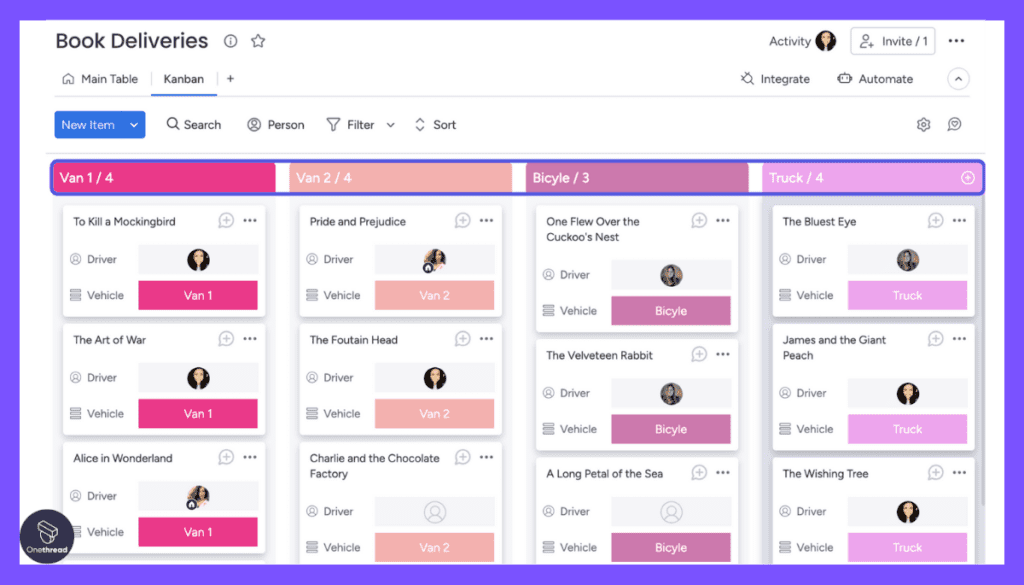
Monday.com shines with its workspaces and boards that are both visually engaging and highly functional. You can set up boards for different projects, departments, or individual sprints. Within each board, items can be categorized, tagged, and prioritized, providing a 360-degree view of ongoing work.
Collaboration & Communication
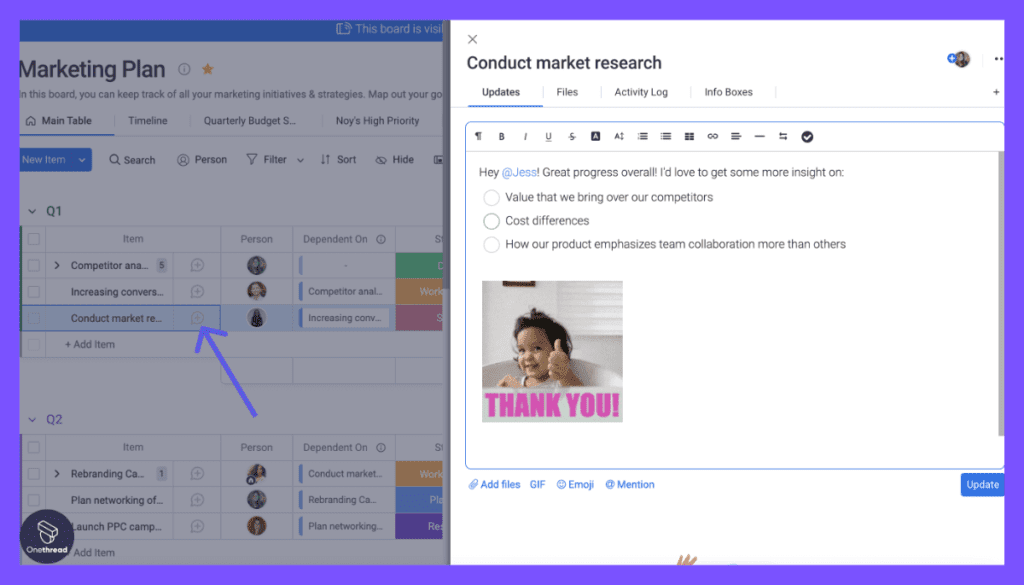
Monday.com takes collaboration to the next level. Each task or item within a board can be clicked on to reveal an entire workspace for discussions, file uploads, and checklists. Team members can tag each other, ensuring everyone is aware of updates or changes.
Automations
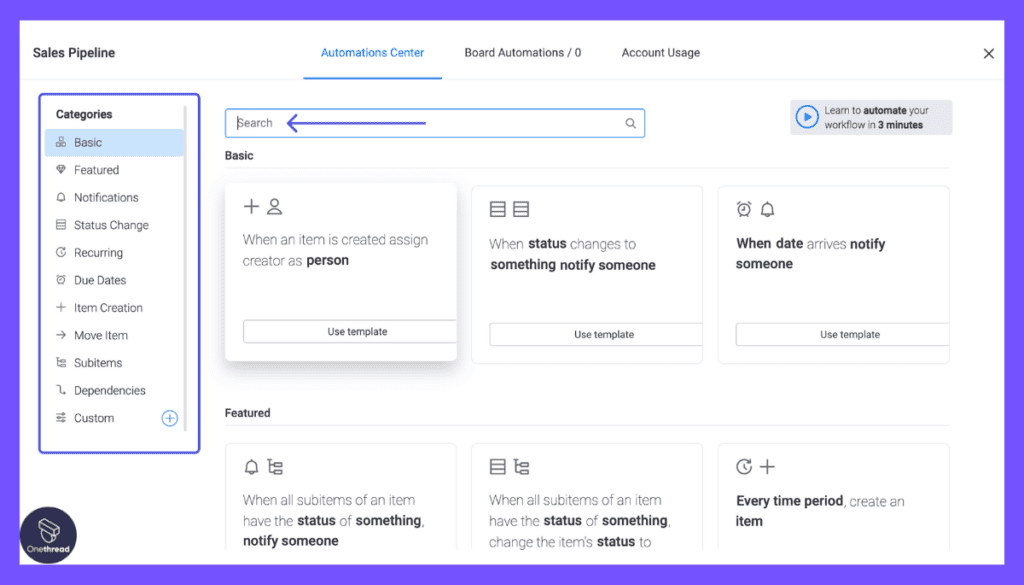
Automation in Monday.com is as advanced as you need it to be. From setting up simple triggers like changing an item’s status to complex chains of actions, the platform offers a multitude of options.
Reporting & Analytics
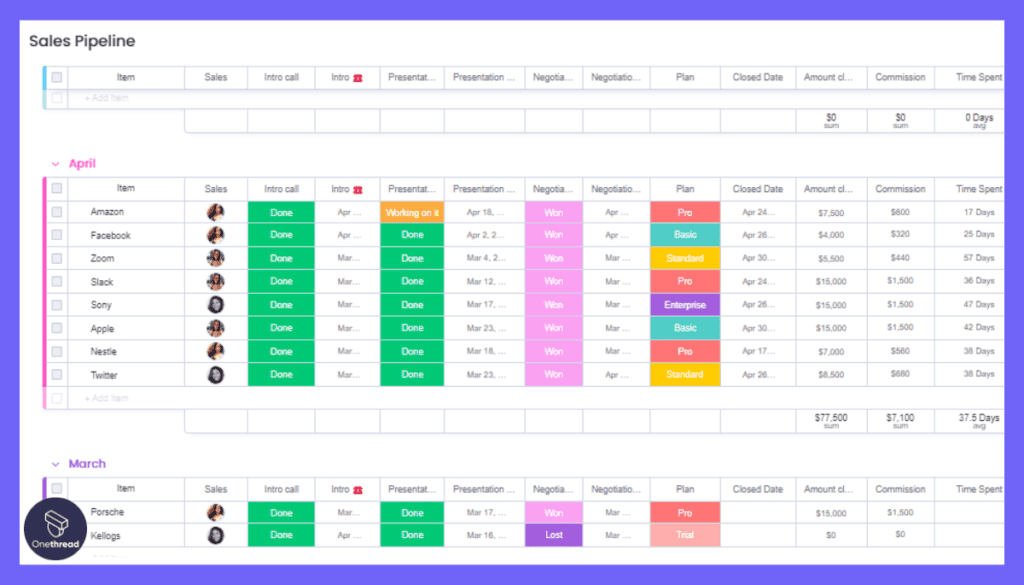
This platform provides robust reporting and analytics tools that go beyond just tracking project status. You can measure team performance, analyze bottlenecks, and assess overall project health.
Integrations
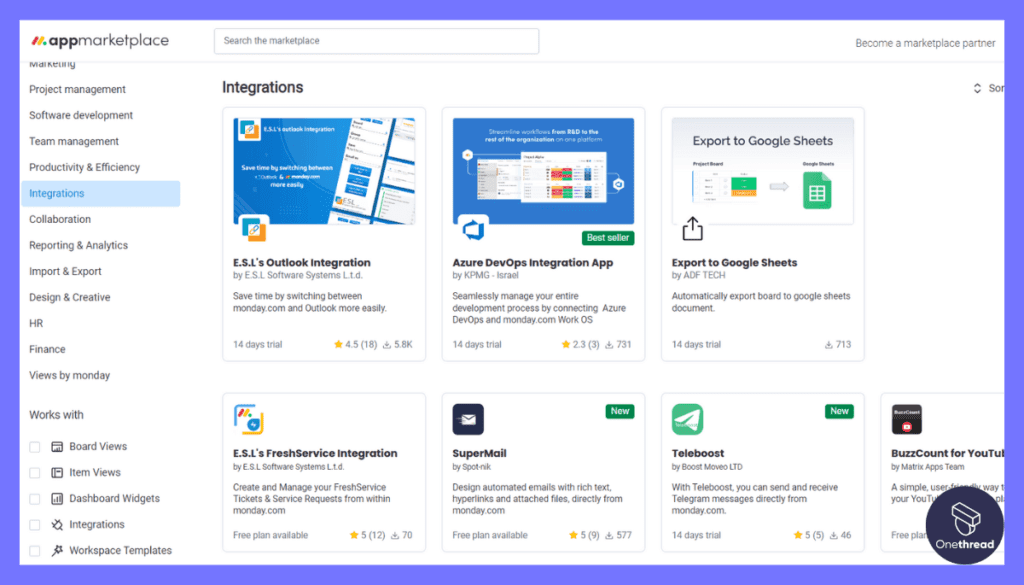
Monday.com boasts a robust list of integrations, from Slack and Zoom to Salesforce and Google Analytics. These integrations allow for a unified work environment where all tools are interconnected. It means fewer tabs, less app-switching, and more focus on the tasks at hand.
Pros & Cons
Pros
- Highly customizable and adaptable to different workflows.
- Comprehensive collaboration and communication features.
- Powerful automation capabilities.
- Robust reporting and analytics.
- Wide range of third-party integrations.
Cons
- Can be overwhelming due to the multitude of features.
- Higher learning curve compared to simpler platforms.
- Pricing can get expensive for larger teams.
Pricing Plans
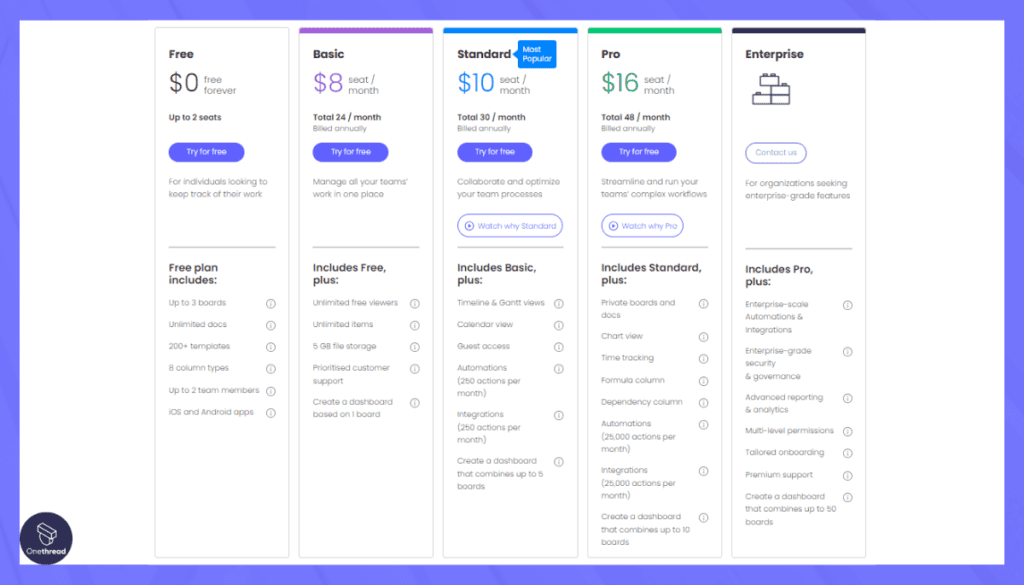
- Individual Plan: Free, but with limited features.
- Standard Plan: $10 per user/month, includes essential project tracking features.
- Pro Plan: $20 per user/month, includes advanced automation and reporting.
- Enterprise Plan: Custom pricing, advanced security, and full feature set.
Customer Ratings
- G2: 4.6 out of 5 stars
- Capterra: 4.5 out of 5 stars
Review
Monday.com is a versatile project management platform with several strengths. It offers a highly customizable interface, allowing teams to create workflows tailored to their needs. Visual project tracking with color-coded boards is a plus. Integration with various apps, including Zoom and Excel, enhances collaboration.
However, Monday.com’s pricing can be steep, especially for small businesses. The learning curve might be steep for some users due to the extensive customization options. Also, advanced features like automations and time tracking may require upgrading to higher-tier plans.
Monday.com is a powerful tool for teams seeking customization and visual project management. But budget-conscious users should carefully consider the cost, and beginners may need some time to adapt to its full potential.
#5. Forecast
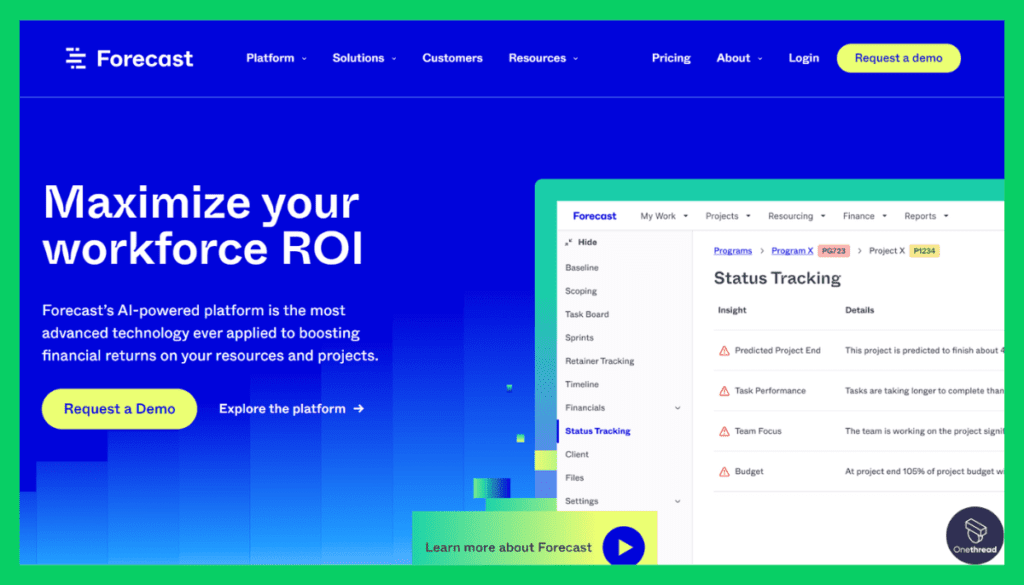
Forecast is a cutting-edge project management and resource scheduling platform designed to optimize your team’s productivity. With its user-friendly interface, Forecast simplifies project planning, budgeting, and tracking.
It allows you to easily create detailed project plans, assign tasks, and set deadlines. Forecast’s intuitive Gantt chart and visual timeline provide a clear overview of project progress.
Its resource management capabilities set Forecast apart, enabling you to allocate team members efficiently and prevent overbooking.
It also integrates with popular tools like Jira and Slack for seamless collaboration. Forecast’s mobile app ensures you stay on top of projects wherever you are. Forecast is the answer if you’re seeking a comprehensive solution to streamline project management and resource allocation.
Forecast – Overview
Founding Team:
- Dennis Kayser:
- Position: Co- Founder and CEO
Features
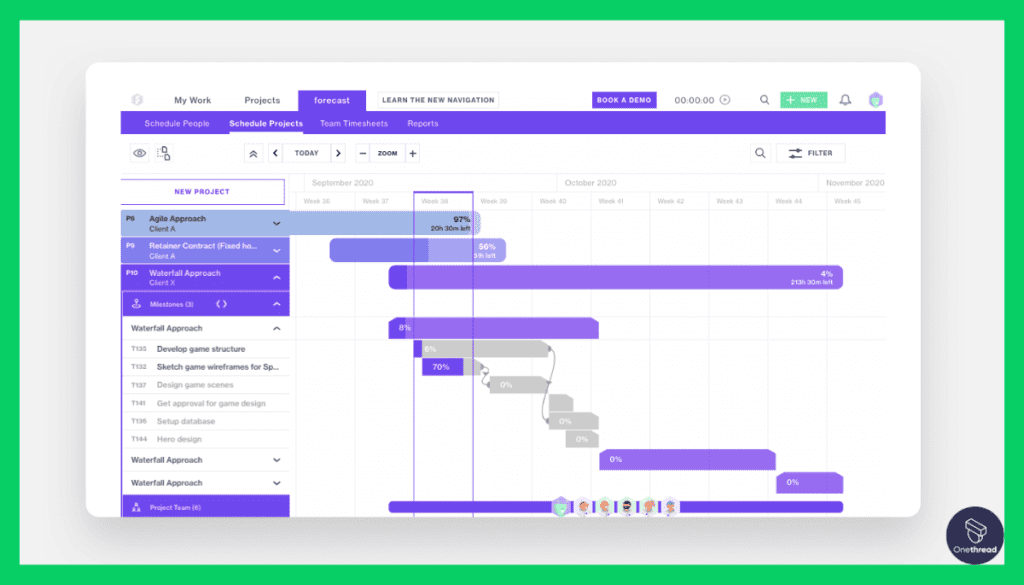
In this comprehensive review, we’ll explore Forecast’s top features, pros and cons, pricing plans, and customer ratings.
Project Planning and Scheduling
Forecast’s project planning and scheduling capabilities are a standout feature. The Gantt chart view offers a comprehensive overview of your project’s timeline, dependencies, and resource allocation.
Resource Management
Effective resource management is crucial for project success, and Forecast delivers in this area. You can see which team members are available, overallocated, or underallocated.
Automation
Forecast simplifies project management through intelligent automation. You can automate repetitive tasks, such as sending out progress reports or assigning tasks based on predefined rules.
Time Tracking and Reporting
Time tracking in Forecast is comprehensive and user-friendly. Team members can easily log their hours, and you can track time against specific tasks or projects.
Customer Portal
Forecast’s customer portal is a unique feature that enhances client collaboration. Clients can access project progress, provide feedback, and view project timelines, all within the platform.
Pros & Cons
Pros
- Powerful project planning and scheduling tools.
- Robust resource management capabilities.
- Intelligent automation streamlines workflows.
- Comprehensive time tracking and reporting.
- Customer portal enhances client collaboration.
Cons
- Learning curve for some advanced features.
- May be more complex than needed for very small teams.
- Pricing can be on the higher side for larger organizations.
Pricing Plans
- Essentials Plan: $29 per user/month, core features for small teams.
- Professional Plan: $49 per user/month, advanced features and automation.
- Enterprise Plan: Custom pricing, tailored solutions for larger organizations.
Customer Ratings
- G2: 4.5 out of 5 stars
- Capterra: 4.4 out of 5 stars
Review
Forecast is a resource management and project planning tool that comes with notable advantages. It offers a visually appealing and easy-to-navigate interface, simplifying project planning and team coordination. The tool excels in its ability to predict project timelines and allocate resources effectively.
On the downside, Forecast can be expensive for smaller businesses, potentially limiting accessibility. Some users might find it overly complex, especially if they’re looking for a more straightforward solution. Additionally, while it integrates with various apps, the range of integrations is not as extensive as some competitors.
Forecast is a robust tool for resource management and project planning, particularly suited for larger enterprises. However, its pricing and complexity may pose a challenge for smaller organizations and those seeking a simpler solution.
Getting the Most Out of Agile Project Management Software

Agile Project Management Software can be a game-changer for your team, but to truly maximize its potential, you need to follow best practices. Here’s a quick rundown:
- Define Clear Objectives: Start with a well-defined project scope, goals, and user stories.
- Regular Planning and Review: Hold regular sprint planning and review meetings to keep your team on track.
- Effective Communication: Use the software’s collaboration tools for clear and open communication among team members.
- Prioritize Tasks: Always prioritize tasks based on importance and urgency.
- Adapt and Iterate: Embrace change and be ready to adapt to new requirements or insights.
- Continuous Learning: Invest time in learning the software’s advanced features to make the most of it.
- Feedback Loops: Create feedback loops with your team and stakeholders for continuous improvement.
- Resource Allocation: Use resource management tools to ensure everyone is optimally allocated.
- Stay Organized: Keep your boards, cards, or tasks well-organized to avoid confusion.
By following these best practices, you’ll harness the full potential of your Agile Project Management Software and propel your projects toward success.
Conclusion
Agile Project Management Software has revolutionized how teams approach and execute projects. Its flexibility, collaboration features, and adaptability to changing circumstances make it an invaluable tool in the fast-paced world of modern project management.
By embracing Agile methodologies and utilizing these software solutions effectively, teams can enhance productivity, improve project outcomes, and stay ahead in today’s competitive landscape.
FAQs
Are there any disadvantages to using Agile Project Management Software?
Disadvantages may include a learning curve for some team members, potential complexity for very small teams, and the need to invest in training for optimal usage.
How do I choose the right Agile Project Management Software for my team?
Consider your team’s specific needs, the scalability of the software, user-friendliness, and the availability of essential features. It’s also helpful to take advantage of free trials and user reviews to make an informed decision.
Can Agile Project Management Software integrate with other tools and software my team uses?
Yes, many Agile software options offer integrations with a wide range of third-party tools such as communication platforms, time tracking software, and more.
Is there a single “best” Agile Project Management Software, or does it depend on individual team needs?
The “best” software depends on your team’s specific requirements, project complexity, and preferences. What works well for one team may not be ideal for another, so it’s important to choose the one that aligns best with your needs.
